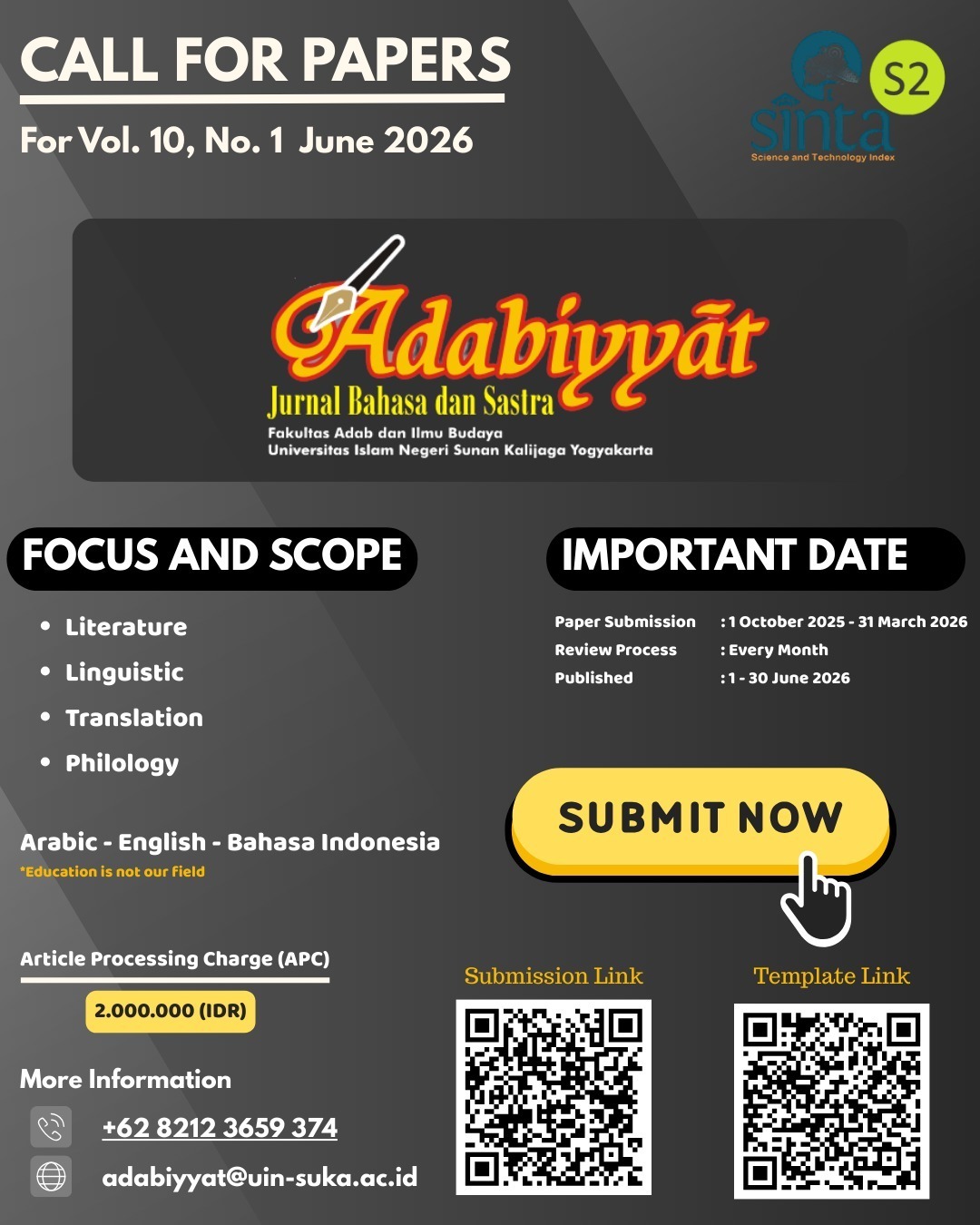REPRODUKSI WOMANHOOD DALAM NOVEL BUNDA: KISAH CINTA 2 KODI KARYA ASMA NADIA
DOI:
https://doi.org/10.14421/ajbs.2017.01203Abstract
Positioning women in literary works by women’s writers almost always has a dynamic turn. Asma Nadia, as a women’s writer is a representation of Forum Lingkar Pena which tends to flip the early women’s narrative model in Reformation era. This narrative model positions women, who are as if in a autonomus and auto-regulative narrative, into their subordinative position. The reversal of women’s narration by women’s writer with the religious perspectives brings up questions like: how is the positioning represented? How are the construction and the position of women in the turning point of the Reformation? What kind of reproduction of womanhood is formed in the novel? This paper aims at investigating the construction of womanhood in the novel with the religious perspectives by Asma Nadia, Bunda Kisah Cinta 2 Kodi. The alternatives in facing the religious structures are negotiated by the writers in various ways. Pardoxes emerge as the consequences of those alternatives.
Downloads
References
Bakhtin, Michail M. 1981. The Dialogic Imagination: Four Essays. Diedit oleh Michael Holquist. Diterjemahkan oleh Caryl Emerson dan Michael Holquist. University of Texas Press slavic series, No. 1. Austin: Univ. of Texas Pr.
______. 1984. Problems of Dostoevsky’s Poetics. Diterjemahkan oleh Caryl Emerson. 12 printing. Theory and history of literature 8. Minneapolis, Minn: Univ. of Minnesota.
Beauvoir, Simone de. 1986. Les Faits Et Les Mythes. Le deuxième sexe, Simone de Beauvoir ; 1. Paris: Gallimard.
Bourdieu, Pierre. 1977. Outline of a Theory of Practice. 25. printing. Cambridge Studies in Social and Cultural Anthropology 16. Cambridge: Cambridge Univ. Press.
_______. 1990. The Logic of Practice. Reprinted. Stanford, Calif: Stanford Univ. Press.
_______. 2002. Masculine Domination. Diterjemahkan oleh Richard Nice. Stanford: Stanford University Press.
Braidotti, Rosi. 1994. Nomadic Subjects: Embodiment and Sexual Difference in Contemporary Feminist Theory. Gender and Culture. New York, NY: Columbia Univ. Press.
Cixous, Hélène. 1976. “The Laugh of the Medusa.” Diterjemahkan oleh Paula Cohen dan Keith Cohen 1 (No 4): 875–93.
Connell, R. W. 2005. Masculinities. 2nd ed. Berkeley, Calif: University of California Press.
Foucault, Michel. 1976. Histoire De La Sexualité: La Volonté De Savoir. Paris: Gallimard.
_______. 1992. The Archaelogy of Knowledge. New York: Random House. Friedan, Betty. 1963. The Feminine Mystique. New York: Norton & Company Inc.
Goldmann, Lucien. 1955. Le Dieu Caché: Étude Sur La Vision Tragique Dans Les Pensées De Pascal Et Dans Le Théâtre De Racine. Ouvrage repr. Collection Tel 11. Paris: Gallimard.
Hill Collins, Patricia. 1990. Black Feminist Thought: Knowledge, Consciousness, and the Politics of Empowerment.
Lauretis, Teresa de. 1987. Technologies of Gender: Essays on Theory, Film, and Fiction. Theories of representation and difference. Bloomington: Indiana University Press.
Mohanty, Chandra Talpade. 2003. “Under the Western Eyes: Feminist Scholarship and Colonial Discourses.” Duke University Press.
Nadia, Asma. 2017. Bunda: Kisah Cinta 2 Kodi. Depok: Asma Nadia Publishing House.
Suryakusuma, Julia I. 1996. “The State and Sexuality in New Order Indonesia.” In Fantasizing the Feminine in Indonesia, diedit oleh L. J. Sears. Durham & London: Duke University Press.
______. 2011. State Ibuism: The Social Construction of Womanhood in New Order Indonesia. Depok, West Java, Indonesia: Komunitas Bambu.
Taylor, Charles. 2004. Modern Social Imaginaries. Public planet books. Durham: Duke University Press.
Tuchman, Gaye. 1978. “Introduction: The symbolic annihilation of women by the mass media.” In Hearth and Home: Image of women in the mass media., diedit oleh G Tuchman, A.K. Daniels, dan J Benet. New York: Oxford University Press.
Udasmoro, Wening. 2009. Pengantar Gender dalam Sastra. Yogyakarta: Fakultas Ilmu Budaya Universitas Gadjah Mada.
______. 2012. “La politique de l’avortement durant la période postsuhartoïste en Indonésie,” no. No 20: 83–100.
______. 2014. Konstruksi Identitas Remaja dalam Karya Sastra. Yogyakarta: Sastra Prancis UGM.
______. 2017. Dari Doing ke Undoing Gender. Yogyakarta: Gadjah Mada University Press.
Walby, Sylvia. 1990. Theorizing Patriarchy. Oxford, UK ; Cambridge, MA, USA: B. Blackwell.
Downloads
Published
Issue
Section
License
Copyright (c) 2017 Wening Udasmoro

This work is licensed under a Creative Commons Attribution-ShareAlike 4.0 International License.
- Adabiyyāt: Jurnal Bahasa dan Sastra publishes all articles entirely in full text.
- It is permissible for readers to download and to use it for scientific purposes and scientific dissemination.
- The author can re-publish the article that has been published by the Adabiyyāt: Jurnal Bahasa dan Sastra after obtaining written permission from the editor. This letter can be obtained by submitting a request letter for permission to republish the article to Adabiyyāt: Jurnal Bahasa dan Sastra via email adabiyyat@uin-suka.ac.id. In the second publication, the author is required to include information that the article was firstly published by the Adabiyyāt: Jurnal Bahasa dan Sastra.



 Google Scholar | H-index [3] Citation [2] |
Google Scholar | H-index [3] Citation [2] | 







